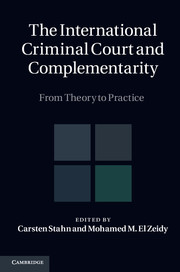Book contents
- Frontmatter
- Contents
- Acknowledgments
- Foreword by HE Judge Sang-Hyun Song
- Foreword by Patricia O’Brien
- Foreword by Silvia A. Fernandez de Gurmendi
- List of abbreviations
- Introduction: bridge over troubled waters?
- PART I General reflections
- PART II Origin and genesis of complementarity
- PART III Analytical dimensions of complementarity
- 7 Complementarity as global governance
- 8 Policy through complementarity: the atrocity trial as justice
- 9 Taking complementarity seriously
- 10 International criminal justice in the era of failed states: the ICC and the self-referral debate
- 11 The quest for constructive complementarity
- 12 Reframing positive complementarity
- 13 Too much of a good thing?: implementation and the uses of complementarity
- PART IV Interpretation and application
- PART IV (Continued) Interpretation and application
- PART V Complementarity in perspective
- PART VI Complementarity in practice
- Index
- References
13 - Too much of a good thing?: implementation and the uses of complementarity
from PART III - Analytical dimensions of complementarity
Published online by Cambridge University Press: 05 November 2014
- Frontmatter
- Contents
- Acknowledgments
- Foreword by HE Judge Sang-Hyun Song
- Foreword by Patricia O’Brien
- Foreword by Silvia A. Fernandez de Gurmendi
- List of abbreviations
- Introduction: bridge over troubled waters?
- PART I General reflections
- PART II Origin and genesis of complementarity
- PART III Analytical dimensions of complementarity
- 7 Complementarity as global governance
- 8 Policy through complementarity: the atrocity trial as justice
- 9 Taking complementarity seriously
- 10 International criminal justice in the era of failed states: the ICC and the self-referral debate
- 11 The quest for constructive complementarity
- 12 Reframing positive complementarity
- 13 Too much of a good thing?: implementation and the uses of complementarity
- PART IV Interpretation and application
- PART IV (Continued) Interpretation and application
- PART V Complementarity in perspective
- PART VI Complementarity in practice
- Index
- References
Summary
This chapter seeks to criticize some of the excesses of the International Criminal Court's complementarity regime when it comes to implementation. The argument is that states are being pushed by transnational civil society to harmonize their domestic laws with the Rome Statute in ways that have little to do with the requirements of complementarity and, instead, reflect traditional human rights and rule of law agendas. I identify several ways in which implementation is being used as a sort of ‘Trojan horse’ for these agendas, and then suggest that the reality of complementarity is that the ICC will almost never find a state unwilling or unable simply because of relatively minor qualitative differences in the substantive or procedural law. The only exception is cases where the absence of implementing legislation makes it impossible for a state to exercise jurisdiction over a crime entering the Court's jurisdiction. I conclude with a few thoughts on what complementarity should be: not so much a stick to beat international criminal law laggards, but a device to manage diversity and pluralism in international criminal law.
Introduction
Complementarity has emerged in the last decade as a formidable leverage to obtain implementation. In fact, one could argue that the virtual effect of complementarity via implementation has outweighed, at least so far, the actual jurisdictional operation of complementarity. Complementarity has become part of the way in which international criminal lawyers project a sense of the ‘international criminal law acquis’, a sort of global package of norms that have to be adopted by states that become part of the ICC club.
- Type
- Chapter
- Information
- The International Criminal Court and ComplementarityFrom Theory to Practice, pp. 361 - 390Publisher: Cambridge University PressPrint publication year: 2011
References
- 8
- Cited by

